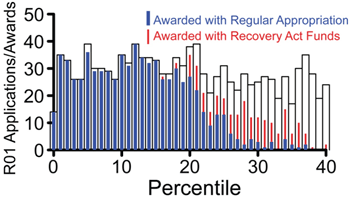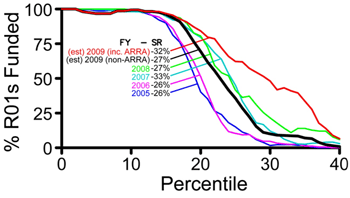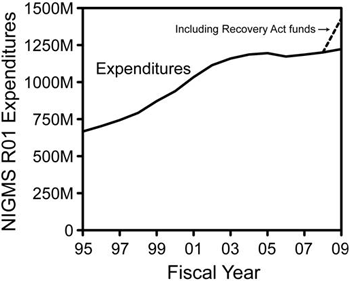Fiscal Year 2009, which ended on September 30, was a time of unprecedented opportunities for NIH due to the American Recovery and Reinvestment Act. As I noted previously, NIGMS used Recovery Act resources to support a variety of funding mechanisms.We have now analyzed the overall results for R01 grants using both our regular appropriation and Recovery Act funds. These results are shown in Figures 1-3.

Figure 1. Competing R01 applications reviewed (open rectangles) and funded (solid bars) in Fiscal Year 2009. The thicker bars (blue) correspond to applications supported using regular appropriated funds, while the thinner bars (red) correspond to applications supported using Recovery Act funds (2-year awards).

Figure 2. NIGMS competing R01 funding curves for Fiscal Years 2005-2009. For Fiscal Year 2009, two curves are shown. The thicker curve (black) corresponds to grants made with regular appropriated funds, while the thinner curve (red) includes grants made with both regular appropriated and Recovery Act (ARRA) funds. The success rate for R01 applications paid with regular appropriated funds was 27%, and the midpoint of the funding curve was at approximately the 22nd percentile. This percentile is slightly lower than that for Fiscal Year 2008. The success rate for R01 applications paid with regular appropriated and Recovery Act funds in Fiscal Year 2009 was 32%, with a midpoint on the funding curve near the 30th percentile. The curve including Recovery Act-funded awards is fairly broad because NIGMS considered additional factors in making funding decisions for Recovery Act awards.
The total NIGMS expenditures (including both direct and indirect costs) for R01 grants are shown in Figure 3 for Fiscal Year 1995 through Fiscal Year 2009.

Figure 3. Overall NIGMS expenditures on R01 grants (competing and noncompeting, including supplements) in Fiscal Years 1995-2009. The dotted line shows the impact of awards (including supplements) made with Recovery Act funds. Results are in actual dollars with no correction for inflation.
We are analyzing additional data on NIGMS funding trends and will be posting these results on the NIGMS Funding Trends Web site.




